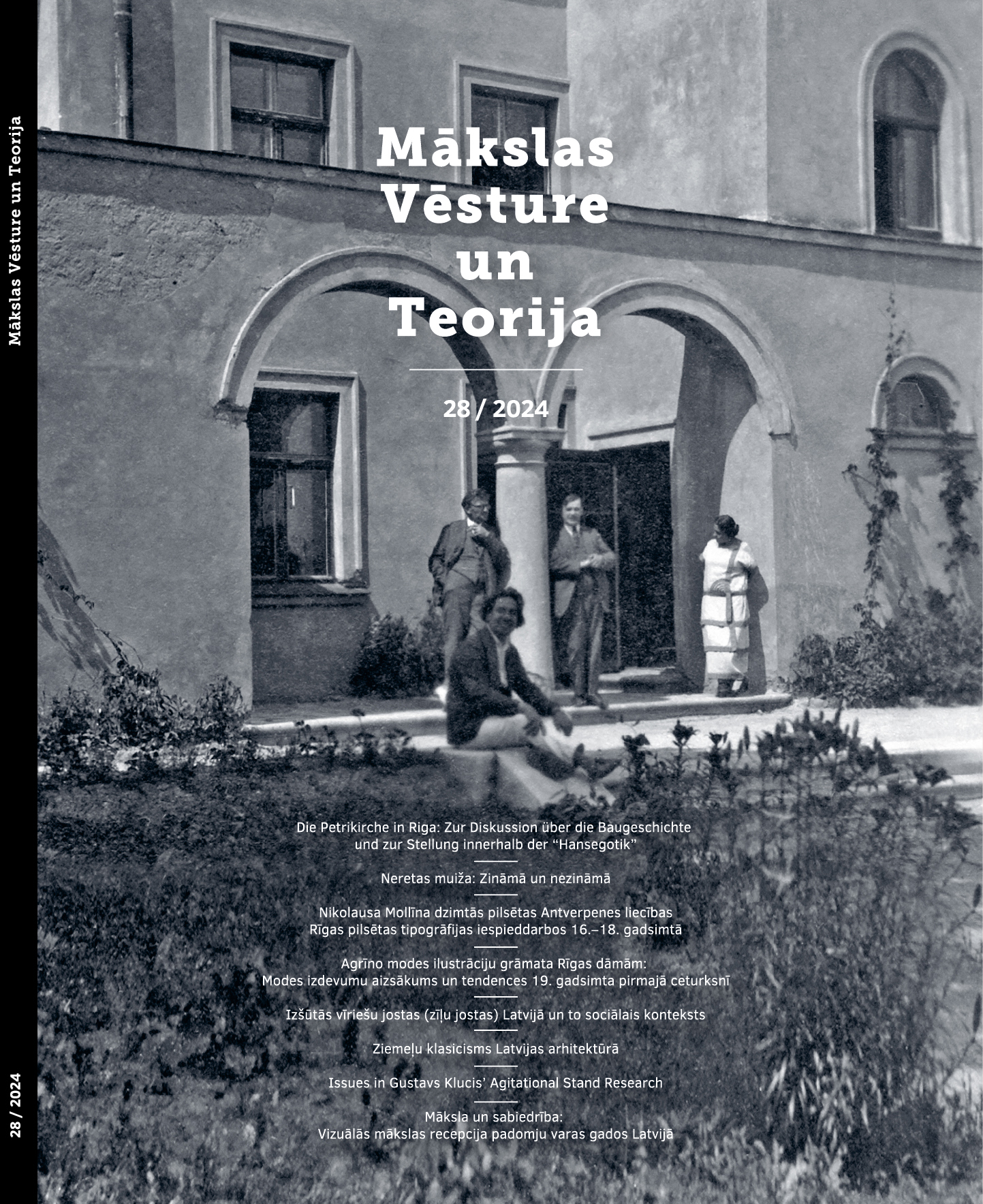Ziemeļu klasicisms Latvijas arhitektūrā
Nordic Classicism in the Architecture of Latvia
Author(s): Karīna HorstaSubject(s): Architecture, Visual Arts, Interwar Period (1920 - 1939), History of Art
Published by: Mākslas vēstures pētījumu atbalsta fonds
Keywords: Nordic Classicism; Architecture of Latvia; Swedish architecture; Gunnar Asplund; Ragnar Östberg; Ivar Tengbom; Pauls Kundziņš; Ernests Štālbergs; Jūlijs Biķis; Verners Vitands;
Summary/Abstract: Nordic Classicism is a generally accepted term denoting Neo-Classicism in the architecture of Nordic countries during the first third of the 20th century. However, it has not been used in Latvia’s architecture and art history circles till now. The aim of this article is to examine the aptness of this term, exploring examples of Latvia’s inter-war period Neo-Classicism and comparing them with Nordic equivalents, especially in Sweden and Finland. Nordic Classicism is distinguished from other sub-trends of the period’s Neo-Classicism by Nordic architects’ ambitions to interpret the classical tradition individually, rationalisation and modernisation while maintaining local roots and using it to add harmony to the environment. This style inherited its interest in vernacular architecture, the environmental context, local building materials and craft traditions from turn of the century Nordic National Romanticism. Although Nordic Classicism is formally broad, it is typified by such traits as light, geometrical architectural volumes, plain or scarcely decorated, smooth façades and roof lights, and the use of both classical and non-classical elements, including deliberately atectonic solutions, disproportions or peculiarly deformed décor. Sweden and Finland were the main sources of Nordic Classicism in Latvia, as Latvian intellectuals, including architects, purposely developed cultural contacts with these countries. Latvian architects were less familiar with the Danish and Norwegian contribution. Nordic Classicism in Latvia emerges as one sub-trend of Neo-Classicism. Several examples below are consistent with the ideological frameworks and formal features of Nordic Classicism, including more direct influences or analogies with Nordic countries as well as Latvia’s original contribution. Similarly to other styles, Nordic Classicism entered Latvia via examples seen by architects in Swedish and Finnish architectural journals or inspected in situ during their regular trips to these countries. Most influential among professionals has been the work of Swedish architects Gunnar Asplund (1885–1940), Ragnar Östberg (1866–1945) and Ivar Tengbom (1878–1968). However, imitation was not an issue, as Latvian architects had a thorough academic education, allowing them to deftly synthesise forms; they only sometimes purposely emphasised a certain style or aesthetic concept. The Stockholm Concert Hall (Ivar Tengbom, 1920–1926) was a prominent and popular example that influenced the work of several Latvian architects, such as Daugavpils Unity House (1936–1937) by Verners Vitands (1903–1982), Bank Pavilion (1937) in Jelgava by Pauls Kundziņš (1888–1983), etc. Conversely, the Stockholm City Hall (Ragnar Östberg, 1910–1923) became a textbook example for administrative buildings, especially during Kārlis Ulmanis’ authoritarian regime. Reference to its typical lantern tower is seen in several competition designs for public buildings and unrealised architectural designs of the period. How to develop a national architecture was the main question during the inter-war period architecture of Latvia. Architect and professor Pauls Kundziņš’ legacy stands out as the most original from this perspective, including his Ikšķile Lutheran Church (1931–1933) with its fine proportions, smooth façade planes and harmonised composition of the main façade, perfectly coinciding with the aesthetic programme of Swedish Nordic Classicism. Kundziņš introduced slender columns in Latvian architecture, and they became a kind of typical Latvian order element. His professional and scholarly contacts in Sweden raised Kundziņš’ authority among students and colleagues – his brother Haralds Kundziņš (1898–1981) and students Ansis Kalniņš (1903–1944) and Verners Vitands took over his architectural principles. Less pronounced was Latvian architects’ interest in the local classical heritage – Baroque and Classicist architecture. However, a shining example is the Talsi Leper Hospital Church mortuary (1936–1938) by Jūlijs Biķis (1895–1969); its architectural volume references the sacred heritage of the Duchy of Courland and Semigallia. Some of Latvia’s Nordic Classicist highlights comply with the tendency to enhance buildings with southern elements, referencing Italian architecture. One of the most competent and educated experts of classical architecture in Latvia was architect and pedagogue Ernests Štālbergs who had thoroughly studied the architecture of Classical Rome, Palladianism and Italian Mannerism, travelling to Italy on a regular basis. He skilfully used this knowledge in practice, creating buildings with pronouncedly southern flavour, such as theatre director Eduards Smiļģis’ private house in Riga (1923–1924), Ķemeri State Bathing Institution (1924–1925) and actors’ sanatorium Talija (1924–1927). A fascination with Italy typifies also the Trikāta New Cemetery Chapel (1934–1935) designed by Lidija Hofmane-Grīnberga (1898–1983). Pēteris Ārends (1900–1960) created an abstracted classical colonnade for the grave of the poet Rainis (1932), using the local Rauna tufa, both a Latvian element and a visual equivalent to Italian travertine. One can broaden the space of Nordic Classicism to include Latvia, as architects here sought not only to modernise but also localise the classical tradition. However, Nordic Classicism cannot be applied to the entire Neo-Classicist architecture of inter-war period Latvia. Conformity with this sub-trend can be established with the formal analysis and studies of the architect’s aesthetic conceptions. Comparison between examples of Latvia and Nordic countries reveal influences alongside similar traits and stylistic parallels. However, the Neo-Classicist architecture of Latvia had its local specificity, mainly derived from vernacular building traditions and the local architectural school. Thus Latvia’s Nordic Classicism had its unique features, but they were markedly close to ideas, mentality, aesthetic concepts and civic ideals current throughout Northern Europe.
Journal: Mākslas Vēsture un Teorija
- Issue Year: 2024
- Issue No: 28
- Page Range: 67-81
- Page Count: 15
- Language: Latvian
- Content File-PDF

